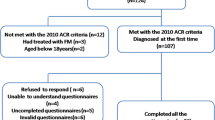Abstract
The aim of the present study was to examine the in-depth application of the Short-Form-(SF)-36 Health Survey to score the general well-being in fibromyalgia syndrome (FS) patients. Quality of life was evaluated in 12 patients with FS. With respect to mental well-being (social functioning, role limitation due to emotional health problems, and mental health), two distinguished groups were found concerning psychological functioning. One group (n = 8) demonstrated psychological dysfunction, whereas the other (n = 4) showed normal psychological scores. Physical well-being scores (physical functioning, role limitation due to physical health problems, bodily pain, general health, and vitality) did not differ between FS patients but were altogether below the normal range. Regarding the psychological scores of the two groups of patients, SF-36 can be used to differentiate between patients with and without psychological dysfunction independent of pain. Therefore, we propose that the SF-36 could be of help to provide the most adequate therapy to achieve an optimal outcome in patients with FS and psychological disturbances.

Similar content being viewed by others
References
Mease P (2005) Fibromyalgia syndrome: review of clinical presentation, pathogenesis, outcome measures and treatment. J Rheumatol Suppl 32:2063
Goldenberg DL (1987) Fibromyalgia syndrome. An emerging but controversial condition. JAMA 257:2782–2787
Wolfe F, Smythe HA, Yunus MB, Bennett RM, Bombardier C, Goldenberg DL, Tugwell P, Campbell SM, Abeles M, Clark P et al (1990) The American College of Rheumatology 1990 criteria for the classification of fibromyalgia. Report of the multicenter criteria committee. Arthritis Rheum 33:160–172
Giesecke T, Williams DA, Harris RE, Cupps TR, Tian X, Tian TX, Gracely RH, Clauw DJ (2003) Subgrouping of fibromyalgia patients on the basis of pressure-pain thresholds and psychological factors. Arthritis Rheum 48:2916–2922
Müller W, Schneider EM, Stratz T (2007) The classification of fibromyalgia syndrome. Rheumatol Int 27:1005–1010
Arnold LM, Hudson JI, Keck PE, Auchenbach MB, Javaras KN, Hess EV (2006) Comorbidity of fibromyalgia and psychiatric disorders. J Clin Psychiatry 67:1219–1225
Talamo J, Frater A, Gallivan S, Young A (1997) Use of the short form 36 (SF36) for health status measurement in rheumatoid arthritis. Br J Rheumatol 36:463–469
Birrell FN, Hassell AB, Jones PW, Dawes PT (2000) How does the short form 36 health questionnaire (SF-36) in rheumatoid arthritis (RA) relate to RA outcome measures and SF-36 population values? A cross-sectional study. Clin Rheumatol 19:195–199
Ofluoglu D, Berker N, Güyen Z, Canbulat N, Yilmaz IT, Kayhan O (2005) Quality of life in patients with fibromyalgia syndrome and rheumatoid arthritis. Clin Rheumatol 24:490–492
Birtane M, Uzunca K, Tastekin N, Tuna H (2007) The evaluation of quality of life in fibromyalgia syndrome: a comparison with rheumatoid arthritis by using SF-36 Health Survey. Clin Rheumatol 26:679–684
Ware JE, Snow KK, Kosinski M, Gandek B (1993) SF-36 Health Survey: manual and interpretation guide. The Health Institute, Boston
Thieme K, Turk DC, Flor H (2004) Comorbid depression and anxiety in fibromyalgia syndrome: relationship to somatic and psychosocial variables. Psychosom Med 66:837–844
Arnold LM, Hudson JI, Hess EV, Ware AE, Fritz DA, Auchenbach MB, Starck LO, Keck PE Jr (2004) Family study of fibromyalgia. Arthritis Rheum 50:944–952
Khoury MJ, Beaty TH, Liang KY (1988) Can familial aggregation of disease be explained by familial aggregation of environmental risk factors? Am J Epidemiol 127:674–683
Guo SW (2000) Familial aggregation of environmental risk factors and familial aggregation of disease. Am J Epidemiol 151:1121–1131
Acknowledgment
Dr. S. Salemi was supported by the Zurzach and the Olga-Mayenfisch foundation, and PD Dr. H. Sprott was supported by the American Fibromyalgia Syndrome Association (AFSA) and the EMDO foundation.
Author information
Authors and Affiliations
Corresponding author
Rights and permissions
About this article
Cite this article
Oswald, J., Salemi, S., Michel, B.A. et al. Use of the Short-Form-36 Health Survey to detect a subgroup of fibromyalgia patients with psychological dysfunction. Clin Rheumatol 27, 919–921 (2008). https://doi.org/10.1007/s10067-008-0874-4
Received:
Revised:
Accepted:
Published:
Issue Date:
DOI: https://doi.org/10.1007/s10067-008-0874-4



